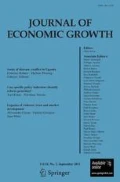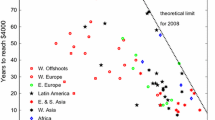Abstract
The relative price of capital has declined at a rapid rate in the postwar period.This article provides a candidate explanation for this relative price decline—research and development that are embodied in new, more efficient investment goods. The model mimics the secular aspects of the data, and it has the property that the long-run growth rate of consumption is nontrivially determined as a function of the R and D efforts. Because growth is driven by investment in durable goods in the present model, it seems natural to assume that R and D is product-specific and that the firms producing these goods are long-lived profit centers that internalize the dynamic gains from R and D. A result of this assumption is that the growth rate in the decentralized economy is too low: the so-called business stealing effects that may cause the equilibrium growth rate to be too high in other models is internalized here in the form of planned obsolescence.
Similar content being viewed by others
References
Aghion, P., and P. Howitt. (1992). “A Model of Growth Through Creative Destruction,” Econometrica 60(2), 323–352.
Gordon, R. (1990). The Measurement of Durable Goods Prices. Chicago: NBER, University of Chicago Press.
Greenwood, J., Z. Hercowitz, and G. W. Huffman. (1988). “Investment, Capacity Utilization and the Business Cycle,” American Economic Review 78(3), 402–418.
Greenwood, J., Z. Hercowitz, and P. Krusell. (1997a). “Long-Run Implications of Investment-Specific Technological Change,” American Economic Review 87(3), 342–362.
Greenwood, J., Z. Hercowitz, and P. Krusell. (1997b). “The Role of Investment-Specific Technological Change in the Business Cycle.” Mimeo. European Economic Review (forthcoming).
Grossman, G., and E. Helpman. (1991). Innovation and Growth in the Global Economy. Cambridge, MA: MIT Press.
Krusell, P. (1995). “Dynamic Returns to R&D and the Size Distribution of Firms.” Mimeo.
Pesendorfer, W. (1995). “Design Innovation and Fashion Cycles,” American Economic Review 85(4), 771–792.
Romer, P. M. (1990). “Endogenous Technological Change,” Journal of Political Economy 98(5: 2), S71–S102.
Segerstrom, P. (1991). “Innovation, Imitation, and Economic Growth,” Journal of Political Economy, 99(4), 807–827.
Solow, R. M. (1959). “Investment and Technical Progress.” In K. Arrow, S. Karbin, and P. Suppes (Eds.), Mathematical Methods in the Social Sciences. Stanford: Stanford University Press.
Author information
Authors and Affiliations
Rights and permissions
About this article
Cite this article
Krusell, P. Investment-Specific R and D and the Decline in the Relative Price of Capital. Journal of Economic Growth 3, 131–141 (1998). https://doi.org/10.1023/A:1009701518509
Issue Date:
DOI: https://doi.org/10.1023/A:1009701518509




